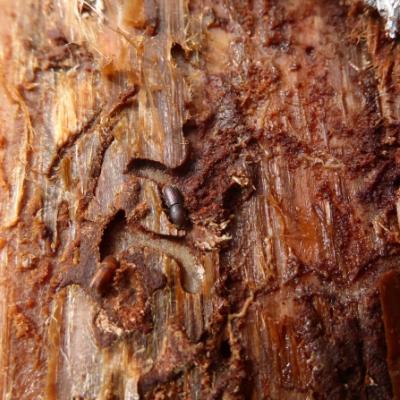Forest Journal
- Tags:
- Working Forests
Peeling a pine to look for insects which will hasten fungal decay including blue stain.
White Pine, Blue Stain
After a wind storm, how long do fallen white pine logs last?
High winds experienced in many parts of the state this past summer and autumn blew down large trees, temporarily knocking out power and blocking roads. When live trees blow down, a clock begins ticking. Wood is perishable. White pine in particular has a limited shelf life with many native NH insects and fungi waiting for their opportunities.
During a March storm, strong winds toppled mature pine trees on the Forest Society’s Whittemore Forest Reservation in Lyndeborough. The forest had recently been the site of a “shelterwood” timber harvest, a type of cut designed to reinvigorate the forest by stimulating new growth, while still leaving some large trees in the overstory. Blowdown of this type is a well-known risk when establishing a shelterwood harvest, especially in a pine stand that had been dense and of mediocre quality. For this reason, the trees that were selected to remain uncut were of good quality and vigor.
But the wind event in March was strong enough to blow down about 30 good quality mature white pines. The consulting forester who administered the harvest alerted us to this blowdown, and asked us whether we’d like to arrange a harvest to salvage and sell the wood. The benefits to such a salvage harvest would be to clean up the mess made by the downed trees and possibly generate a little revenue. On the other hand, leaving the wood to decay on the ground would increase the habitat complexity of the forest, and the material would be readily used by many of our region’s mammals, amphibians and reptiles.

The Forest Society eventually decided to leave the fallen pines for wildlife, but during the decision making process, a simple question arose: how long would the pine trees last before they were invaded by insects and fungi that would render the timber’s value worthless?
We asked around. It turns out the answer to this question was not well known. Some research had been done on the longevity of cut pine logs, but this seemingly didn’t apply to our situation, in which the pine trees were still partially connected to their root system and many had live needles in their fallen crowns. Isabel Munck, a plant pathologist with the U.S. Forest Service, expressed interest in examining the site to see if we could learn more. If we had the question, she reasoned, others might also. How long would the timber in the toppled pine trees last?
Isabel and the property’s longtime volunteer land steward, Greg Kreider, met Forest Society staff and interns on site to tag trees and collect information. We peeled the bark off many trees and examined them for signs of insects and fungi. The pine engraver beetle can detect the smell of dead pines and arrive on site within a matter of days. This beetle is thought to be the main vector of several types of sap stain fungi which can turn wood blue and greatly decrease its monetary value to a landowner. Interestingly, this fungus does not harm the wood’s structural strength, but most sawmills will refuse wood that shows sign of the blue stain.
We discovered the pine engraver beetle as well as several other types of insects that are attracted to dead or dying trees. And indeed, two-thirds of the blown-over trees showed signs of sap stain fungus. Interestingly, about one-third of the trees, despite being on the ground, were still living (green needles) and had not yet been affected by insects or any sap stain fungus. The timber in these trees was sill salvageable about five months after the blowdown event had occurred.
The rate at which trees die and decay following a blowdown is likely affected by many factors. Most important is probably the season in which it occurs and the subsequent weather and forest floor temperature. Timber from blowdowns that occur in winter is likely to last longer than those which occur in summer or in hot, dry conditions.
More blowdown events need to be analyzed to get a more precise picture of all the factors at play. This one snapshot look at the forest following a blowdown was a fascinating way to learn about the transition trees undergo after they hit the ground and those insects and fungi that play important roles.
So if a tree falls in the forest, it may not make a sound… until beetles begin munching beneath the bark.
